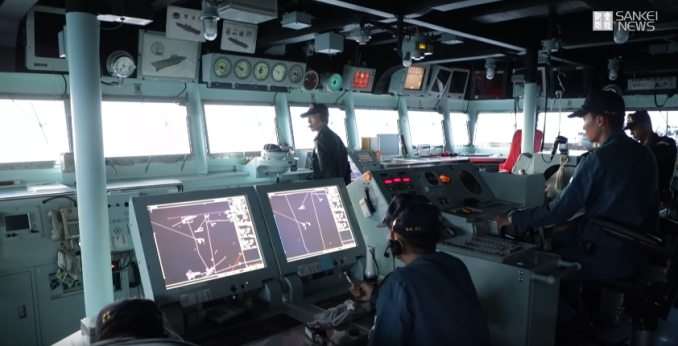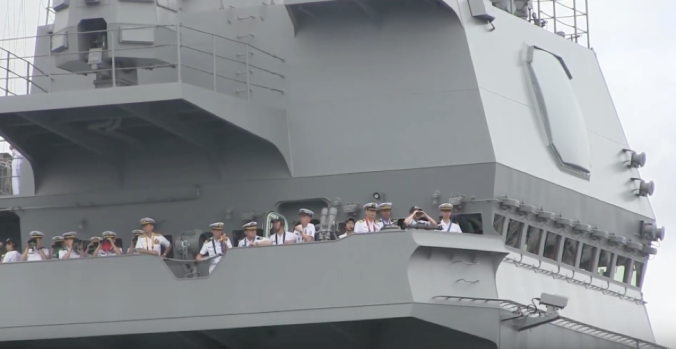
Izumo-class, the largest surface combatant in Japan, was put into service with the Japanese Maritime Self Defence Force (JMSDF) in March 2015. The Izumo Class destroyer ships replace the Hyuga-class destroyers, which were commissioned in March 2008.
The vessels can be used for multiple purposes, including anti-submarine warfare, command-and-control operations, humanitarian aid and disaster relief operations, as well as to protect Japanese territories in the East China Sea.

Japan Marine United Corporation, which was created by the integration of two companies, Universal Shipbuilding and IHI Marine United, custom-built the two Izumo-class ships at the Yokohama shipyard. The construction of Izumo-class destroyer was conceptualised by the Japanese Ministry of Defense (MOD) in November 2009. JMOD received a budget of 118.1 billion yen for the fiscal 2010 for the construction of a helicopter destroyer.
Construction of the first ship in the class, JS Izumo (DDH-183), began in 2011 at Yokohama shipyard. Its keel was laid down in January 2012 and the vessel was launched in August 2013. It was commissioned at Yokosuka port in Japan in March 2015. Investment on the vessel amounted to approximately ¥120bn ($1.01bn).
Keel for the second ship in the class was laid down in October 2013, and its launch will take place in August 2015. Commissioning will take place by March 2017.
Ships


DDH-184 JS KAGA
Although a Japanese naval vessel may be retrofitted to carry fighter jets, the ruling parties will call the Izumo a “multi-purpose operation destroyer” to avoid criticism that use as an aircraft carrier would violate the pacifist Constitution.
Members of the ruling parties’ working team on revising the National Defense Program Guidelines, which the government expects to approve later this month, reached a consensus on what to call the Izumo-class destroyers during a meeting on Dec. 5.
The Abe administration has been considering retrofitting the Maritime Self-Defense Force’s Izumo into an effective aircraft carrier that can deploy U.S.-made F-35B stealth fighter jets, which can take off and land vertically.
However, an issue on how to maintain compatibility of the use with the war-renouncing Article 9 of the Constitution will likely remain a problem with the Izumo becoming a de facto offensive aircraft carrier, the first in the Japanese fleet.
The 248-meter-long vessel would be reliant on its complement of F-35Bs, resulting in exceeding the defensive nature as specified in the Constitution.
In the meeting, Defense Ministry officials explained the plan of thickening the decks of two Izumo-class destroyers, which carry helicopters, and making other adjustments so that F-35Bs can be launched from there, according to a source who attended the meeting.

The following is the gist of the new National Defense Program Guidelines and the fiscal 2019-2023 midterm defense buildup program approved by the Cabinet, Japan:
- will upgrade Izumo-class helicopter carriers so that they can transport and launch fighter jets.
- will buy 18 F-35B fighter jets capable of short takeoffs and vertical landings.
- will beef up defense in new domains of warfare such as cyber and outer space.
- aims to build “multidimensional” defense capabilities for operations across various domains.
- expresses “strong concern” over China’s military activities.
- will install two land-based Aegis missile systems.
- will spend over ¥27 trillion — a record — in the five-year period.

The island structure, including the platforms, with five levels, is about around 70m long. Like the Hyuga class, considerable attention has been paid to reducing signatures. The 243m flight deck allows for relatively unimpeded aircraft movement and is able to simultaneously operate five helicopters. Weapons, except for the forward CIWS on the starboard side of the flight deck, are mounted on hull sponsons or the island structure. Another notable difference from the Hyuga class is the aft 14m x 15m deck edge elevator on the starboard deck edge behind the island structure. The forward 20m x13m elevator remains on the centreline as on the Hyuga class. There are three small elevators for weapons and supplies, two forward, one aft.
Operating F-35B on Helicopter Carrier
Japan’s cabinet has approved a major additional purchase of 105 F-35s to add to the 42 aircraft already on order. Significantly, the number includes 42 of the F-35B STOVL (short takeoff, vertical landing) version, which will operate from island bases along Japan’s western seaboard and two converted Izumo-class helicopter carriers. Japan also approved work to modify the vessels, Izumo and Kaga, to operate up to 10 F-35Bs each—including deck strengthening. The announcement confirms Japanese press reports that have been circulating since earlier in the year.
Japan is considering refitting the Izumo helicopter carrier so that it can land U.S. Marines F-35B stealth fighters, government sources said on Tuesday, as Tokyo faces China’s maritime expansion and North Korea’s missile and nuclear development.
Japan has not had fully fledged aircraft carriers since its World War Two defeat in 1945.
Design features of Izumo-class destroyer

The Izumo-class destroyer has a length of 248m, beam of 38m, draught of 7.5m and depth of 33.5m. Its displacement is 19,500t when empty and 27,000t when fully loaded. It can complement 970 crew and troops, and as many as nine helicopters including seven anti-submarine warfare (ASW) helicopters and two search and rescue (SAR) helicopters.
Bridge



JS Izumo (DDH-183)
The destroyer features a spacious flight deck that can accommodate five helicopters to take off and land simultaneously. It also includes roll-on and roll-off ramp, and interior space for up to 50 vehicles.
Sensors and processing systems fitted to the vessel include OYQ-12 combat direction system, FCS-3 fire control system, OPS-50 AESA radar, OPS-28 surface-search radar, and OQQ-23 bow sonar.
FCS-3 fire control system

JS KAGA DDH-184
FCS-3 is an integrated naval weapons system developed by the Japanese Defense Ministry for the Japan Maritime Self-Defense Force.
This system is composed of weapon-direction and fire-control subsystem and multi-function radar subsystem. The multi-function radar subsystem adopted active electronically scanned array (AESA) technology, and there are two sets of antennas: the larger one is a C-band radar for surveillance and tracking, the smaller one is a X-band radar as a fire-control radar.
After a prolonged sea trial on board JS Asuka, this system was introduced in 2007 on the JS Hyūga (DDH-181). The enhanced version, FCS-3A, was employed on the Akizuki-class destroyers., and limited-function version, OPS-50, was also delivered for the Izumo-class helicopter destroyers. The fire-control function are omitted in the OPS-50 system, so they have only one set of antennas operating C-band.
OPS-50 AESA radar

The illumation radar is capable of Continous Tracking Capability [Phased Array Radar], Pulse Doppler Radar (Full LDSD Capability), Interrupted Continuous Wave Illumination. The J/OPS-50 MFR is a FCR capable of engaging Surface-to-Air and Surface-to-Surface Medium-Range missile range up to 222.2 km.
OPS-28 surface-search radar

JS KAGA DDH-184
The radar can Track While Scan (TWS) up to 203.7 km, Pulse Doppler Radar (Full LDSD Capability). The scan to max altitude 30480 metres. The J/OPS-28D is a Target Indicator radar, 2D Surface-to-Air and Surface-to-Surface with max range 203.7 km.
OQQ-21 bow sonar (OQQ-23 bow sonar)
The Hull-mounted Active/Passive sonar can track a submarine or ship up to 74.1 km.
Weapon systems fitted on Izumo-class destroyer

The Izumo-class destroyer is fitted with two Phalanx close-in weapon system (CIWS) guns, and two SeaRAM CIWS launchers. It is also equipped with electronic warfare and decoy systems, including NOLQ-3D-1 EW suite, Mark 36 SRBOC, anti-torpedo mobile decoy (MOD), and floating acoustic jammer (FAJ).
NOLQ-3D-1 EW suite

JS KAGA DDH-184
The J/NOLQ-3D-1 ESM has a range of 926 km, operated onboard JS Izumo, had Separate ESM Antenna for ESM countermeasures. The J/NOLQ-3D-1 ESM can perform ELINT w/ OTH Targeting.
Izumo-class destroyer propulsion and performance
The Izumo-class destroyers are propelled by four GE/IHI LM2500IEC gas turbine engines, which generate a power of 112,000hp (84,000kW). They can sail at a top speed of more than 30kn (56km/h).

Specification
| Displacement standard, t | 19500 |
| Displacement full, t | 24000 |
| Length, m | 248.0 |
| Breadth, m | 23.5 wl 38.0 fd |
| Draught, m | 7.30 |
| No of shafts | 2 |
| Machinery | COGAG: 4 General Electric-IHI LM-2500 gas turbines |
| Power, h. p. | 112000 |
| Max speed, kts | 30 |
| Fuel, t | gas turbine oil |
| Endurance, nm(kts) | 6000(20) |
| Armament | 2 x 21 Sea RAM SAM (42 RIM-116), 2 x 6 – 20/76 Mk 15 Block 1B Phalanx, 5 x 1 – 12.7/90, 14 helicopters (SH-60, MCH-101) |
| Sensors | OPS-50, OPS-28D, FCS-3, OPS-20 radars, OQQ-23 sonar, NOLQ-3D-1 ECM suite, 6x SRBOC Mk 36 decoy RL, OLQ-1 anti-torpedo system, ACDS CCS |
| Complement | 470 |
© 2020, GDC. © GDC and www.globaldefensecorp.com. Unauthorized use and/or duplication of this material without express and written permission from this site’s author and/or owner is strictly prohibited. Excerpts and links may be used, provided that full and clear credit is given to www.globaldefensecorp.com with appropriate and specific direction to the original content.







Be the first to comment